“PowerWalk”- Sustainable Energy Tiles harnessing Footstep Energy
Abstract -
The increasing demand for sustainable energy solutions and the growing challenges of urbanization have compelled innovators to explore new avenues for harnessing clean energy. Sustainable energy sources harness naturally replenishing sources of energy to generate power without depleting finite reserves or emitting greenhouse gases. These sources offer a clean and enduring solution to the world's energy demands reducing dependence on nonrenewable fossil fuels. The "PowerWalk" project presents an innovative sustainable energy tile that capitalizes on the kinetic energy produced by human footsteps in high footfall urbanareas. Through the utilizationofpiezoelectric sensors the prototype efficiently converts footstep-generated mechanical stress into electrical energy. This paper delves into the design and construction of the "PowerWalk" tiles, its optimization for energy-harvesting. The study also highlightsthe materials'selection, mechanicalstrength, and the impact of PowerWalk in reducing carbon emissions by providing renewable energy sources in urban environments. The future scope of the project explores diverse implementation areas, and the environmental implications of large-scale adoption. The "PowerWalk" prototype showcases a promisingandpractical solution for promoting sustainable energy initiatives and creating cleaner and greenerurbanlandscapes.
Key Words: Sustainable Energy, Footfall, Mechanical Energy,PiezoelectricSensors,

1.INTRODUCTION
Conventional energy generation methods, predominantly reliant on fossil fuels, have proven detrimental to the planet's delicate ecological balance. The energy sector is responsible for approximately [1] 73% of global greenhouse gas emissions (IEA, Global Energy & CO2 Status Report 2020), underscoring the urgent need to transition to sustainable and low-carbon energy sources. M
Harvesting energy is one of the most effective ways in which we can combat this issue. In this light, with the numberof people residingincitiessteadilyrisingthere is a dynamic realm of bustling activity, particularly in high footfall areas. According to the United Nations'
projections, [2] approximately 68% of the world's population is expected to live in urban areas by 2050, making sustainable energy solutions in cities crucial for global emissions reduction. Pavements can serve more than a space for walking. The sheer magnitude of pedestrian traffic in these urban centers presents an untapped reservoir of kinetic energy. High footfall areas have an[3]averageof70to100stepsperminuteduring peakhours(JournalofPhysicalActivityandHealth,2011). By converting the kinetic energy produced by human footsteps into usable electricity, a unique opportunity is presented to capture renewable energy from an inexhaustiblesource-pedestrianmovement.
The seamless integration of these tiles into public spaces and high-footfall areas offers a dual benefit: supplementingthelocalpowergridwithcleanenergyand encouraging public engagement with sustainable practices. The conversion of these everyday movements into electrical power offers a compelling opportunity to harnesscleanenergywithseamlessintegrationintopublic spaces without disrupting urban environments or requiringadditionalresources.
1.1 Problems Addressed
Thisresearchprojectfocusesonaddressingseveralcritical problems including sustainable energy, the increasing population, and promoting physical activity through walking.
Addressing these interconnected problems requires innovative approaches and sustainable energy solutions that promote environmental consciousness and the adoptionofhealthierlifestyles.
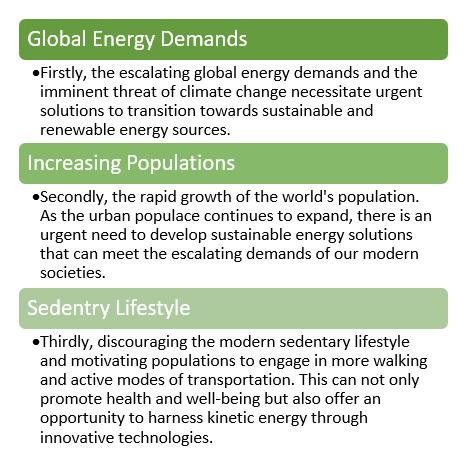
2. PROPOSED SOLUTION
The proposed prototype, "PowerWalk," is an innovative sustainable energy tile concept specifically tailored for seamless integration within bustling urban pavements, wherehighfootfallareaspavethewayforarichsourceof kinetic energy waiting to be harnessed. Each PowerWalk tile contains an arrangement for piezoelectric sensors, foam, and springs sandwiched between triangular plywood sheets. With six piezoelectric sensors and six springs in each tile, the pressure on the sensors is
optimized to convert mechanical stress into electrical current.Beyond its energy-harvesting capabilities, PowerWalk also exemplifies user-friendliness. Adorned with LED lights on each tile, this device communicates to passersby, instilling an environmental consciousness and fostering a sense of appreciation for sustainable innovations. By connecting each tile in series, the voltage generated during use is increased. This energy is then directed to a lithium battery to ensure efficient and practical utilization of the harnessed energy, making PowerWalk a dependable and self-sustaining source of renewableelectricity.
2.1 Scope
This project's focused scope revolves around testing and optimizing various models and mechanisms for these Sustainable Energy Tiles. Through rigorously evaluating piezoelectric sensors and materials, the aim is to identify the most efficient energy conversion mechanism from footstep-generatedmechanicalstress.Theultimategoalis to create a functional prototype of six tiles that can effectivelyharnesskineticenergyfromhigh-footfallareas. Comprehensiveperformanceevaluationswillguidedesign refinements and economic feasibility considerations, contributingtoasustainablefuture.
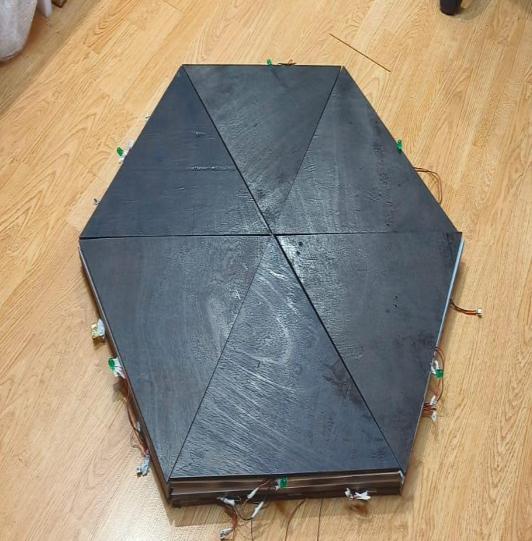
2.2 Importance of Kinetic Energy harvesting
The human body possesses abundant kinetic energy due to its dynamic movements, sudden accelerations, and substantial displacements. This inherent energy potential can be harnessed as a viable power source, offering an intriguing supply option for low-power electronic devices with power density levels of 1mW/cm³ or 1mW/g. Utilizing piezoelectric transduction during activities like walking, with a frequency of approximately 1 Hz, can theoretically reach power density limits as high as 343mW/cm³, and practically up to 19mW/cm³.Daily activities such as walking have shown great potential for generating significant power. This underscores the importance of implementing energy harvesting technologies to provide electricity for low-powered devices,turningusersintobothproducersandconsumers of energy. The frequency of human movements generally remains below 10 Hz, with step frequencies during walking varying from 1.2 to 2.2 Hz, depending on the average walking speed. Various locations on the body, such as the ankle and knee, display higher accelerations, making them more energetic regions for power generation. Kinetic energy harvesters, employing piezoelectric, electromagnetic, electrostatic, or magnetostrictive mechanisms, play a crucial role in convertingthiskineticenergyintoelectricalpower.

3. IMPLEMENTATION AND WORKING PRINCIPLE

3.1 Shape of the Tile
To understand and implement the optimal shape of the tile, Finite Element Analysis (FEA) analysis was undertaken on the Autodesk Inventor software, experimentingwiththetwomostcommonshapesoftiles, square and triangle. [4] This analysis aids in identifying the most suitable shape that optimizes energy harvesting and ensures structural integrity, guiding the iterative designprocessforcreatinganefficientanddurabletile.
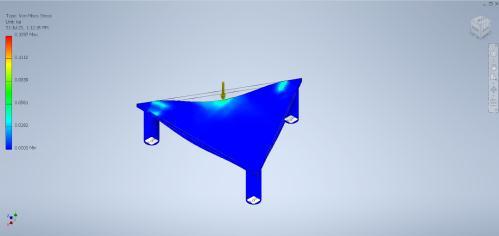

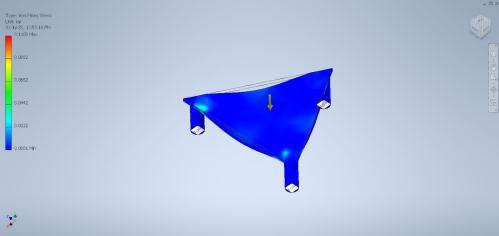

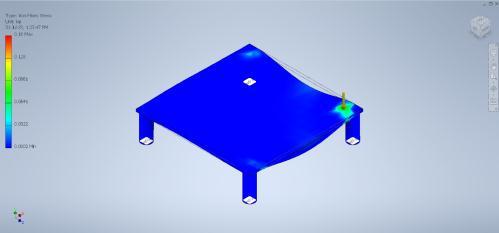
corneroralongthesideofthesquare(Fig3.2and3.3),at most only 3 piezos are engaged and 2 sides undergo compression.
Fortheanalysisthesideof eachfigure wasgivenalength of17.5inches,thethicknessofeachplateis10mmandthe stilts are 30mm long. The material chosen was plywood. Theweightassignedforeachforcewas55N.
Stress, strain and displacement analysis of a square: As seenintheImagesabove,whenasquaretilesupportedby stilts (to be imagined as columns with piezo sensors beneath them) is compressed at different areas on the surface, the compression of the upper plate differs. Only whenonestepsinthecenterofthetile(Fig3.1)areallthe stilts compressed and engaged, hence only then all four piezos are in use. On the other hand if one steps on the
Stress, strain and displacement analysis of a triangle: On the other hand, on analyzing the triangular model, wherever a human where to step, in the center, on the perimeter or at the vertices, each steps allows for all piezoelectric sensors to be engaged at once, seen by the compressionofallthreesidesofthetriangle.Moreover,in square tiles, stress accumulates at the corners, which could lead to uneven energy generation or structural issues.Alsoduetoatrianglesthree-sidedstructure,forces are distributed more evenly, making them less prone to wobbling or instability. Triangular tiles' robust structural properties make them more resistant to external pressures,impacts,andloaddistribution.Thisisespecially relevant in practical applications where the tiles may experiencevaryinglevelsofstress.
As a result, the triangular shape was chosen for the tiles over the square shape to ensure efficient generation of energyfromeachsensorforeachstep.
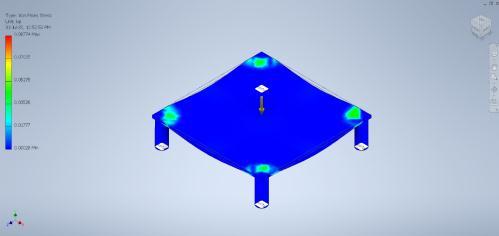
Piezoelectric sensors are an electrical component that converts a mechanical or thermal input into an electrical signal.. As the tile is compressed due to pressure exerted by the human body while walking the sensor comes into contactwiththeprojectionsonthetilesurface.Thisallows for polarization of these materials, resulting in the distributionofelectricalchargesacrosstheirsurface.
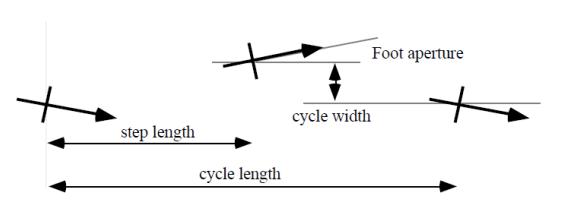
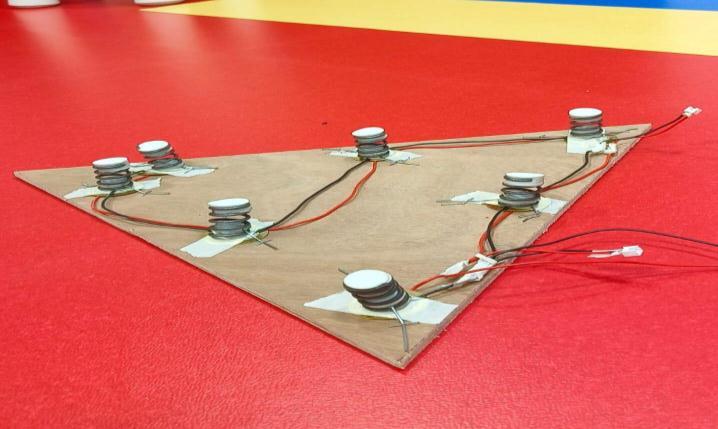

Piezoelectric sensors are the main device used in the prototype for the conversion of energy. There are many forms of piezoelectric materials, the one used being copper with a diameter of 35mm and output voltage of 1.1v. Due to their smaller size, higher energy density, simple structure and low cost they were utilized in this model.[5]Moreovertheydonotrequireaseparateinitial voltage source, allowing them to be easily incorporated into systemsin a compact manner required for suchtiles. Moreover they are much more sensitive, as studied for producing power from smaller scale vibrations like footsteps.Asaresulttheyhavebeenincorporatedintothis prototype over other potential choices like electromagnetics and electrostatic transducers. Each sensor has been joined in the tiles using a series connection,resultinginantheoreticaltotalvoltageof6.6V across each tile. Contrastingly had they been in a parallel connectionthetotalvoltageinthecircuitwouldhaveonly been1.1v.
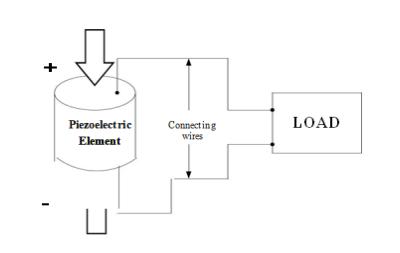
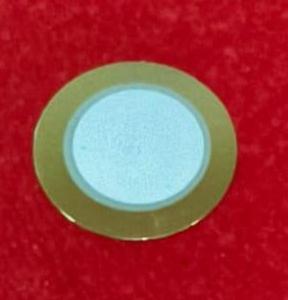
3.3 Outside Material
The selected material for the pavement must be robust and durable. Tensile strength and Compression strength assessment is necessary to determine the material's capacity to withstand compressive forces to bear the weightandfrompedestrianswithoutcrushing.Elongation at break evaluation is essential to understand the material's flexibility and resilience over time. Poisson's ratio analysis is necessary to assess the material's lateral deformation response under stress and ensures the tiles
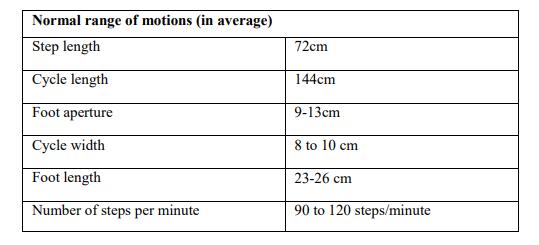
can efficiently convert mechanical stress into electrical energy without excessive energy loss.Finallythe material selected must also be cost effective to ensure the scalabilityandviabilityoftheenergytilesonalargerscale. Hence a comparative study was undertaken to decide on thematerialtobeusedfortheprototype.
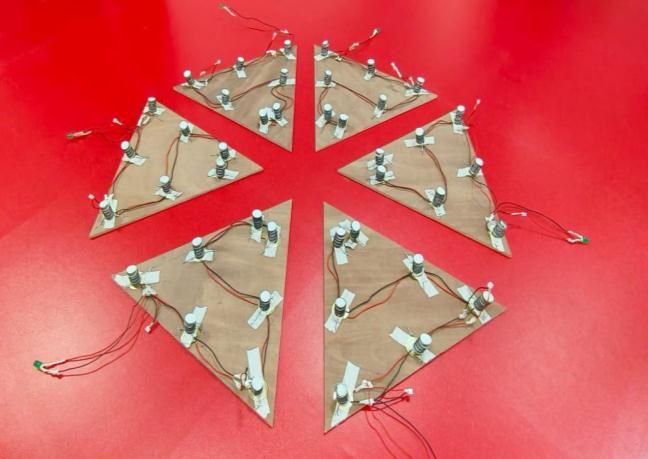
Cost effectiveness MDFis generally themost costeffective option amongthe three materials

Woodcanbe relatively costeffective, especially when sourcedfrom sustainable forestry
Aluminium tendstobe themost expensive optionamong thethree materials.
As seen on comparison, although Aluminium 3003 had overall best durability and elongation at break, due to its high costs in the markets wood was selected as the materialforthisprototype.Moreovertheeaseofworking with wood in terms of customization and adaptation to specific project requirements using basic hand tools and woodworking skills. Hence ply wood triangle sheets of sidelength444.5mmandwidthof10mmwereusedasthe top and base for each tile. Each piece was lazer cut to ensureprecisioninthesizingofeachtile.
3.4 Mid layer Material
Between both plates of wood, a combination of springs andfoamwasusedforthecrucialpurposeofallowingthe transfer of pressure from the surface of the tile to the piezoelectricsensorsonthebottomsurface.
It was realized that by only using foam in the preprototype, under deformation caused by pressure the tile tooklongertorestoreitsoriginalshape.Moreover,foam's ability to absorb impact rather than dissipate the vibrations produced might inadvertently dampen the mechanical stress applied to the piezoelectric sensors, resultinginreducedenergyconversion.
Conversely,theuseofonlyspringsinthetilemightleadto unmitigated transfer of footfall pressure to the piezoelectric sensors. This might subject them to abrupt mechanical force, potentially leading to premature wear and damage. Additionally, it could create an uncomfortablewalkingsurfaceforpedestrianswherethis isanessentialconsideration
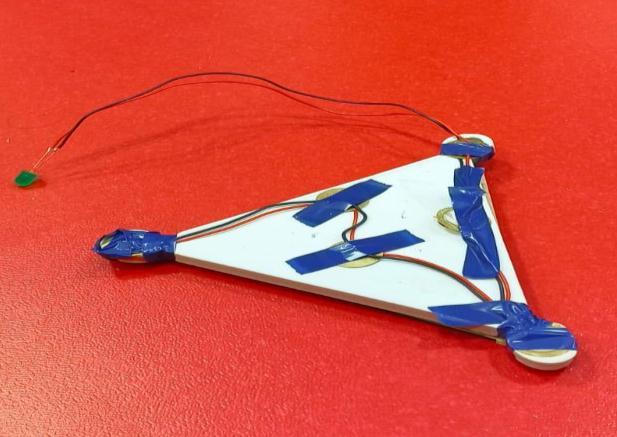
Hence a combination of both materials was used in each tile. 10mmfoamwasusedtopreventwearandtearofthe sensors and protect them from excessive mechanical damage while also providing comfort in each step. While the 3mm diameter springs were kept slightly longer than the foam layer, and also directly above each piezo to ensure the mechanical pressure was directly transferred tothesensortoensureincreasedenergyproduction.

4. RESULTS

To understand and analyze the effectiveness of each tile separately on undergoing mechanical stress, physical testingwascarriedoutonthepreparedtile.5testsubjects of different weights were asked to walk on the tile for different lengths of time. The table below records the variationsinvoltagegeneratedbyeachsubject.
Chart -1:VariationofTimewithVoltageGenerated
The voltage generated depends on the force that is being appliedtotheelectrictile.Intheorywhenabiggerperson pumpsonthiselectrictile,thevoltagethatisgeneratedis higher compared to the smaller person. There should hence be a linear relationship between the two. This is solidified by the fact that for each time band in the graph thevoltagegeneratedbysubject1isgreaterthanthatof2, whoseweightishigher.Atthesametimetheoreticallythe time the force is applied for should also lead to a higher yieldofvoltage. Thisisalsoprovedthroughthetesting as with an increase in time there is a linear increase in the voltagegenerated.
5. FUTURE SCOPE
To better understand the variation of time with the voltage generated a graph of the results has also been presented.
The future scope of the "PowerWalk" project holds immense potential for growth and impact. Advancements inmaterialssciencecouldleadtothedevelopmentofeven more efficient piezoelectric materials with higher energy conversionrates,enablingincreasedelectricitygeneration from footstep-generated mechanical stress. Additionally, exploring novel materials with superior mechanical properties could enhance the durability and longevity of the tiles, allowing them to withstand more extensive and diverse urban environments. The implementation of "PowerWalk" can extend beyond city pavements to encompass various high footfall areas, such as shopping malls, stadiums, airports, and public transportation hubs, exponentially multiplying its energy-harvesting capacity. Another option could be the installation in bumpers on roads where the pressure of the car remains the highest. As "PowerWalk" tiles continue to be deployed in urban landscapes worldwide, they could collectively contribute to significant reductions in carbon emissions by generating clean, renewable energy from otherwise
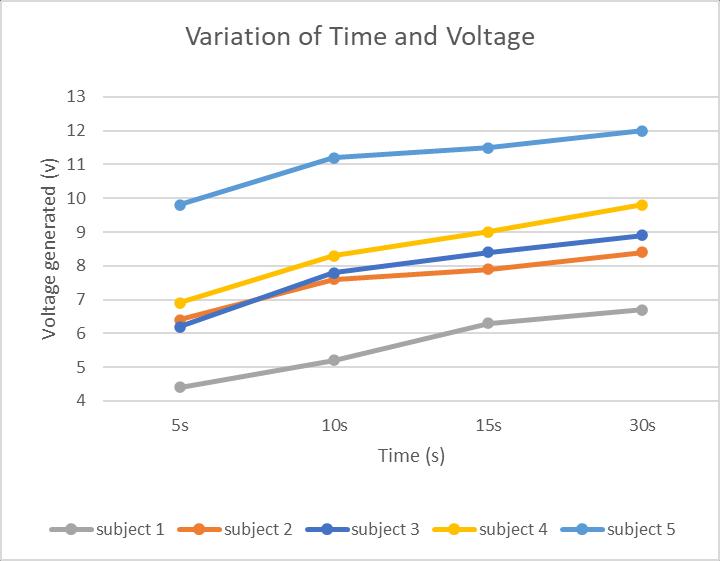
wasted kinetic energy. Embracing this sustainable technology on a larger scale has the potential to revolutionize urban energy consumption and promote a greener and more environmentally conscious future for ourcities .
5. CONCLUSION
This project designed tiles that harvest kinetic energy off of pedestrian walking and also provides a comfortable surface for pedestrians as well. The proposed pavement tile consists of piezoelectric materials sandwiched between layers of plywood, foam and springs. The study examined different designs of tiles, materials, connectors and layers to obtain the optimum condition. The results show that the arrangement of sensors on the outer boundary of the tile covered with sheet of foam can distribute the loads better and subsequently, generate highervoltage.Thestudyrecommendsthatitisespecially suitedforimplementationincrowdedareasasmostofthe kinetic energy of waking people is wasted, even though it canbeharvestedthroughanenergy-harvestedtile.
REFERENCES
[1]“ExecutiveSummary–ElectricityMarketReport2023–Analysis-IEA.”IEA,

[2] 68% of the World Population Projected to Live in UrbanAreasby2050,SaysUN|UNDESA|UnitedNations DepartmentofEconomicandSocialAffairs.
[3] Tudor-Locke, Catrine, et al. “Walking Cadence (Steps/Min) and Intensity in 21–40 Year Olds: CADENCEadults.” International Journal of Behavioral Nutrition and PhysicalActivity,vol.16,no.1,SpringerScience+Business Media,17Jan.2019
[4] Vanz, E.; Karakiewicz, J. In Computer-Aided Architectural Design Futures. The Next City-New Technologies and the Future of the Built Environment; Springer,2015.
[5] Roundy,S.;Wright,P.K.;Rabaey,J.Astudyoflowlevel vibrations as a power source for wireless sensor nodes. Comput.Commun.2003,26(11),1131.
BIOGRAPHIES
Varsha Sundar

Student
Curious Innovator, driven by an unwavering passion for mechanical innovations. Excited about shaping the future through the fusion of imagination and precision.
Chirag Sharma

Mentor
Technology and Robotics enthusiast with a passion for mentoring and research in fields ofRobotics,AutomationandData Science.
